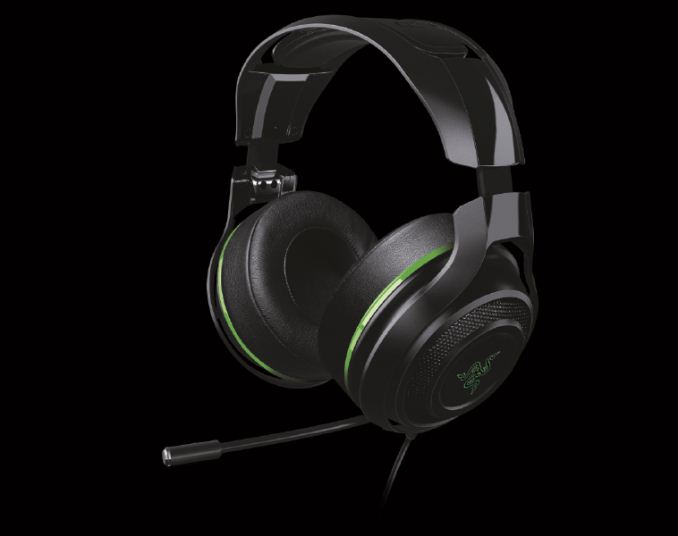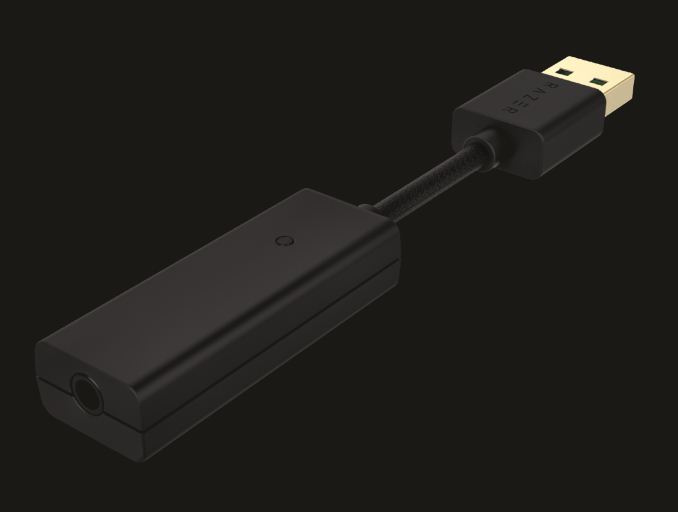Razer Announces Availability Of The Stargazer Webcam And ManOWar 7.1 Headphones At IFA
by Brett Howse on September 2, 2016 4:00 AM EST- Posted in
- Accessories
- Razer

Just a couple of quick announcements from Razer at IFA. First off is the Razer Stargazer webcam finally has a launch date, after initially missing it’s Q2 2016 window. The Stargazer webcam was originally announced at CES and for a full breakdown on the camera, check out our initial post here. As a brief summary, it’s an Intel RealSense 3D webcam which offers Windows Hello support for facial recognition based login, and it targets game streamers with the ability to use the RealSense 3D to remove the background from an image and only overlay the person into the game stream. It also supports 1080p at 30fps as well as 720p at 60fps, which is higher than many webcams if you want to do a 60fps stream. Razer has also dropped the price from the original $199 MSRP to $149. Pre-orders are up now, and shipping will be October 2nd.
They’ve also updated their ManO’War headset with the latest ManO’War 7.1 model. It features 50 mm drivers for virtual 7.1 surround, and offers sound isolation and in-line volume controls. It has a retractable MEMS boom mic, and an included USB digital-to-analog converter for the PC and Mac, or a standard 3.5mm audio jack for compatibility with Xbox, PlayStation, or any other device. It will retail for $119.99 with pre-orders now, and shipping in October as well.
Source: Razer











12 Comments
View All Comments
p1esk - Friday, September 2, 2016 - link
What the hell is this? 1080@30? How about 4k@60? Or at least gimme 1080@120. And yes, I do have the necessary bandwidth.Cygni - Friday, September 2, 2016 - link
It's meant to compete with the dominant webcam, the Logitech C920, which does 1080p at 30fps. These are webcams. The Razer costs $150. There isn't a single $150 4k/60fps camera on the market.Also, we are all ever so impressed by your bandwidth, but uncompressed 4k 60fps video is nearly 711MB (big B) per second. Don't think you've got that kinda bandwidth upstream. Even lossy compressed 4k 60fps video is yuge, and if you are doing that much compression, why are you even shooting in 4k/60... in fact why are you streaming at 4k/60 on a webcam anyway?
p1esk - Friday, September 2, 2016 - link
According to Netflix, I need to have 25Mbps to stream 4k movies. Assuming that's 25 fps, 60 fps would need 60Mbps. Now, video chat is much more compressible than movies (because the picture does not change much), so in reality I would need much less than 60Mbps for 4k@60 video chat. And guess what? I just did my internet bandwidth test: 391Mbps down, 124Mbps up. So yeah, I got plenty for 4k@60 stream.hpglow - Monday, September 5, 2016 - link
Your so cool. will you touch your own weiner for us.Sivar - Tuesday, September 6, 2016 - link
Your behavior is of an insecure 14-yr-old. I say this to inform you, not to deride you. I suggest you observe better manners.With that said, your comment expresses an incomplete understanding of video technology.
Netflix uses well-tuned, precompressed HEVC video for 4K. No PC can encode HEVC in realtime in high quality at low bandwidth. Even a 10-core Broadwell-E cannot realtime encode with settings that would give you good quality at their bit rates, so a webcam, with its limited hardware, would of course have a much harder time.
Now it is entirely possible to stream realtime 4K at fairly poor quality but low bitrates using dedicated encoding hardware, but such hardware is expensive and not in high demand. Why would 4K matter on a webcam -- a device usually used to check when the kids get home, verify the hours claimed by the cleaning crew, or record burglaries?
JoeyJoJo123 - Wednesday, September 7, 2016 - link
So that p1esk can "zoom and enhance" to 1024x magnification on the burglar's license plate, and then keep zooming and enhancing so he can read the dna pairs on the burglar that's escaped.That's how 4k works, right?
knutinh - Saturday, September 10, 2016 - link
In all fairness, broadcast and "broadcast" are different beasts compared to point to point communications. While someone like Netflix can afford to use the very best encoder implementations out there, they have to encode one or a few streams offline for a million customers. This means that the stream must be resilient against poor network and poor customer capabilities. Customers must be able to fastforward in the video.A web camera working in a point to point scenario will have to worry about encoder cost. But unlike netflix, they only need to worry about a single, linear user. And the encoder can adjust to network conditions on the fly.
Finally, the progress of video coding standards is such that by simply going for the next-newest standard, processing cost and chip availability is significantly improved, while bitrate required for a given quality may increase by, say, 2x.
While a web cam can be used for surveilance, that is hardly the only usage. Nor the main usage in my view.
JoeyJoJo123 - Tuesday, September 6, 2016 - link
No 4K/60fps yet, but we are getting close; Action Cams such as the Xiaomi Yi 2 do 4K/30fps and 1080p/120fps and are $250 right now. With a capture card, particularly if it supports it is possible to use action cams (with A/V out) as "webcams", assuming the capture card has "DirectShow" drivers, which allows it to be selectable as a video-in source in programs such as Skype, like other USB webcams.JoeyJoJo123 - Tuesday, September 6, 2016 - link
Correction: No 4K/60fps at $150* yet.ddriver - Friday, September 2, 2016 - link
They sure activated my hilarity unit with pimping the "no green screen needed background removal through intel's AMAZING realsense technology" BS while showing off the practically pathetic and laughable results. Seems like "realsense" will be even more unimpressive than I anticipated. More like "real non-sense". Not only does it ALMOST manage to remove the background, but it also manages to remove the actual person, but as a compensation, leaves behind fugly artifacts.Job well done!